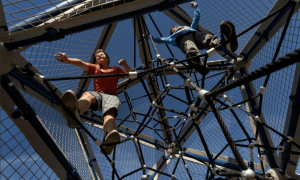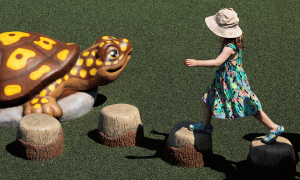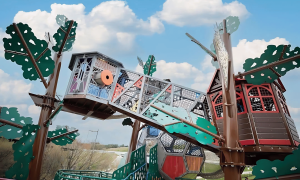In the public domain throughout North American Playgrounds, climbing is routinely one of the most popular activities. When we ask why both children and adults like to climb, play scholars cite the challenge, the ability to get to the top of a structure, whether natural or man-built. Survivalists explain that climbing is part of our wired past as a means of escaping potentially fatal situations. Many professionals explain that when we climb, it's not only to concur but to gain the ultimate reward of the view or vista from the top. If you have ever climbed a mountain, you know exactly what I mean! Height seems to have practical advantages as well. As anyone who has studied military history can tell you, for thousands of years humans have built our forts and castles in high elevated spaces so that we could see our enemies advance from far away. For all these reasons and more, we are naturally attracted to climbing, and it makes sense for climbing to be such a popular playground activity.
In the late 1980s and throughout the 1990s, playgrounds in North America were made SAFER. The resulting actions, spawned by the U.S. Consumer Product Safety Commission combined the American and Canadian Standards Associations' recommendations, all but eliminated super tall climbing apparatus. I'm sure I'm not the only one who remembers from my college Play classes seeing pictures of the original gymnastic play equipment that populated our schools and parks at the turn of the century. This equipment tended to be well over 10' tall, often as high as a two-story building/ Injuries from falls onto a hard surface all by eliminated this type of equipment. Today, if you ask children what they want, and we do, they tell us the taller the better. However, as responsible designers, we must provide adequate safety surfacing materials to attenuate the impact of a direct fall onto the surface below and around the play equipment.
One recent trend has been to enclose or "cage in" the higher elements on super tall climbing structures to prevent a user from falling out of the equipment. This practice is somewhat controversial as published scholars have shown independent research with children using the equipment in manners it was not intended by climbing on the outside of the protective barriers and connecting components. If you are considering placement of these tower type play apparatus, be sure to also consider placing safety surfacing under and around it that protects users from the highest foreseeable point they might fall. Fortunately, IPEMA surfacing manufacturers have made tremendous progress developing materials that meet the ASTM F1292 Safety Standard for impact attentuation to heights that approach 16'!
Another strong trend is the reemergence of cable net-type structures that originated in European playgrounds nearly 40 years ago. Cable net climbers can be designed to eliminate the possibility of a direct fall from the higher climbing areas to the surface directly below and underneath the climber. American, Canadian and European safety standards spell out a test methodology that allows designers to create super tall net structures for climbing. This type of equipment is becoming more and more popular, and hybrid designs are helping create new, fun and exciting play activities in a compliant manner. As a student of play for 30 years, one can surmise that climbing net structures are complex by design and create climbing experiences that develop coordination, crossing the midline, slow the play experience down and develop cognitive skills of decision making, risk taking and problem solving.
The trend of rock climbing in a public space continues to be popular. Natural and manufactured boulders are featured events in many new natural theme park playgrounds. We are seeing an increasing amount of play equipment combining "rocks and ropes" which translates into boulders with either net climber connectors or balance ropes like the "Burma bridge" event. Elementary schools have brought the rock climbing experience into the gymnasiums with horizontal wall climbers that surround the gymnasium walls, are relatively low in height and have protective mats underneath that double as containment when not is use.
Today, as you consider the design of a composite play structure or a freestanding climber, you have a more diverse selection of materials than ever before. Traditional climbers like steel rung ladders are still viable climbers, but you can choose themed steel designs that resemble rope to even steel and/or cable with recycled plastic treads resembling the old rope ladders dropped down the side of a ship or from an elevated tree house. You will find climbers themed to look like logs, rocks, trees, leaves, spider webs, animals like bears, raccoons, etc...today's playground designer has a multitude of options on how they want to theme the traditional climbing activity.
---
Tom Norquist
 NOTE: This article originally appeared in the Summer 2013 issue of Playground Magazine - www.playgroundmag.com
NOTE: This article originally appeared in the Summer 2013 issue of Playground Magazine - www.playgroundmag.com
- Trails (27)
- Schools (191)
- Press Releases (109)
- Playground Funding (5)
- Play Science & Research (62)
- Parks & Recreation (360)
- Outdoor Fitness (138)
- National Demonstration Site (32)
- Landscape Architects (77)
- Inclusive Play (109)
- Daycare and Early Learning (62)
- Custom Play (38)
- College Campus (28)
- Churches (51)
- Challenge Course (30)
- Featured Projects (77)
- BluePrint for Play (18)
- Site and Shade (9)





